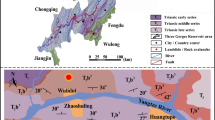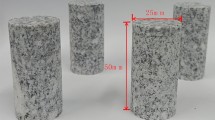Abstract
Fractures in frozen soils are strongly associated with thermal gradient–dependent heterogeneity and significantly affect frost heaving and thaw subsidence in permafrost by altering the soil structure and the moisture migration path. An experimental study was conducted to investigate the quantitative relationship between fracture behavior and stress-induced heterogeneity of frozen soils with a thermal gradient. A series of visualization-aided unconfined compression tests on frozen soil columns with a thermal gradient under various water contents and temperatures was performed. The results indicated that the influences of water content and temperature on the observed fracture can be unified into an heterogeneity level. An increase in the heterogeneity level weakened the peak strength and enhanced the volumetric dilation of the frozen samples. The strain localization zone was the main location for fracture initiation and development, and its range accounted for over 70% of the fracture. The height of the fracture reduced with stress-induced heterogeneity level increased, while its reducing rate was over 2 times more than that of the maximum lateral deformation and strain localization zone. A mean asymmetry coefficient over 1.2 in the heterogeneity level observed at the two sides of the frozen specimens was attributed to the occurrence and change in location of the shear fracture. These observations and findings have significant importance for development of a fracture model that incorporates the influences of stress-induced heterogeneity in frozen soils with a thermal gradient to improve the mathematical formulations on frost heave.













Similar content being viewed by others
References
Abzhalimov RS, Golovko NN (2009) Laboratory investigations of the pressure dependence of the frost heaving of soil. Soil Mech Found Eng 46(1):31–38
Azmatch TF, Sego DC, Arenson LU, Biggar KW (2011) Tensile strength and stress–strain behavior of Devon silt under frozen fringe condition. Cold Reg Sci Technol 68(1–2):85–90
Azmatch TF, Sego DC, Arenson LU, Biggar KW (2012) New ice lens initiation condition for frost heave in fine-grained soils. Cold Reg Sci Technol 82:8-13
Hao SW, Wang HY, Xia MF, Ke FJ, Bai YL (2007) Relationship between strain localization and catastrophic rupture. Theor Appl Fract Mec 48:41–49
Ji YK, Zhou GQ, Zhao XD, Wang JZ, Wang T, Lai ZJ, Mo PQ (2017) On the frost heaving–induced pressure response and its dropping power–law behaviors of freezing soils under various restraints. Cold Reg Sci Technol 142:25–33
Khanin RE (2010) Consideration of frost–heaving forces in designing pile foundation for cellular communications towers. Soil Mech Found Eng 47(1):12–19
Kim SY, Hong WT, Lee JS (2018) Silt fraction effects of frozen soils on frozen water content, strength, and stiffness. Constr Build Mater 183:565–577
Ma W, Zhang LH, Yang CS (2015) Discssion of the applicability of the generalized Clausius-Clapeyron equation and the frozen fringe process. Earth-Sci Rev 142:47–59
Qin YH, Zhang JM, Zheng B, Ma W (2009) Experimetnal study for the compressible behavior of warm and ice–rich frozen soil under the embankment of Qinghai–Tibet Railroad. Cold Reg Sci Technol 57(2–3):148–153
Tao XL (2017) Study of formation mechanism and evolution law of longitudinal cracks in permafrost region subgrade. Ph.D.Thesis. China University of Mining and Technology, Xuzhou, China. (In Chinese)
Wang YT, Wang DY, Ma W, Wen Z, Chen SJ, Xu XT (2018) Laboratory observation and analysis of frost heave progression in clay from the Qinghai-Tibet Plateau. Appl Therm Eng 2018(131):381–389
Xia D (2006) Frost heave studies using digital photographic technique. M.S.Thesis. University of Alberta,Edmonton, Canada.
Xu J, Liu H, Zhao XK (2017) Study on the strength and deformation property of frozen silty sand with NaCl under triaxial compression condition. Cold Reg Sci Technol 137:7–16
Zhao XD, Zhou GQ, Lu GL, Wu Y, Jiao W (2017) Thermal gradient dependent deformation behavior of frozen soil and its mechanism at temperatures close to 0°C. Cold Reg Sci Technol 135:105–115
Zhao XD, Zhou GQ, Chen GZ, Shang XY, Zhao GS (2011) Triaxial compression deformation for artificial frozen clay with thermal gradient. Cold Reg Sci Technol 67(3):171–177
Zhao XD, Zhou GQ, Lv ZY (2019) Radial thermal gradient–dependent deformation behaviors of frozen hollow cylinder. J Cold Reg Eng 33(1): 04018015-1-04018015-10.
Zhou GQ, Hu K, Zhao XD, Wang JZ, Liang HC, Lu GL (2015) Laboratory investigation on tensile strength characteristics of warm frozen soils. Cold Reg Sci Technol 113:81–90
Funding
This research was supported by the National Natural Science Foundation of China (Grant No. 51304209).
Author information
Authors and Affiliations
Corresponding author
Rights and permissions
About this article
Cite this article
Zhao, X.D., Jiao, W. & Zhou, Y. Thermal gradient–dependent fracture behavior of ice-rich frozen soils. Bull Eng Geol Environ 80, 5553–5561 (2021). https://doi.org/10.1007/s10064-021-02269-4
Received:
Accepted:
Published:
Issue Date:
DOI: https://doi.org/10.1007/s10064-021-02269-4




